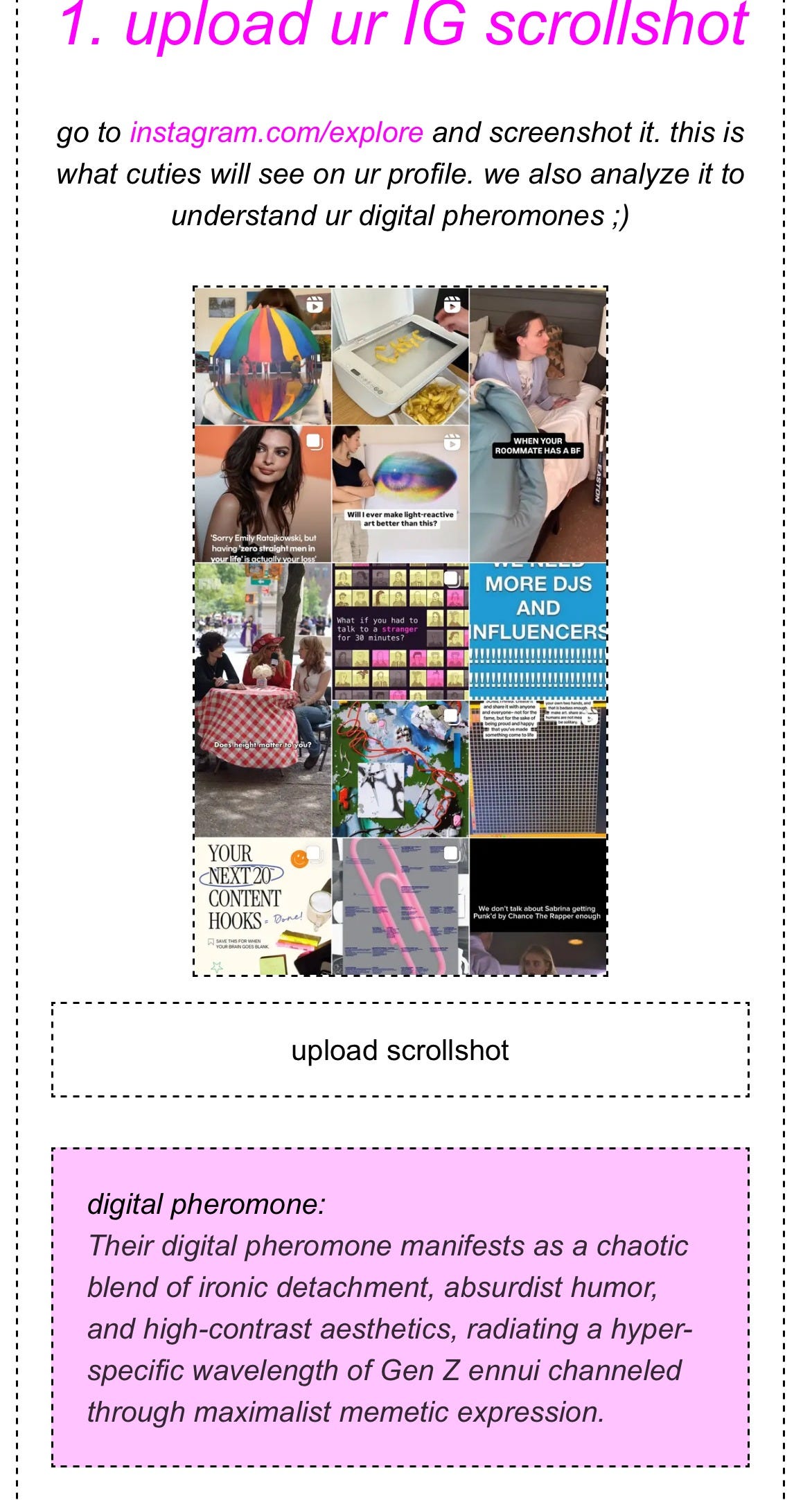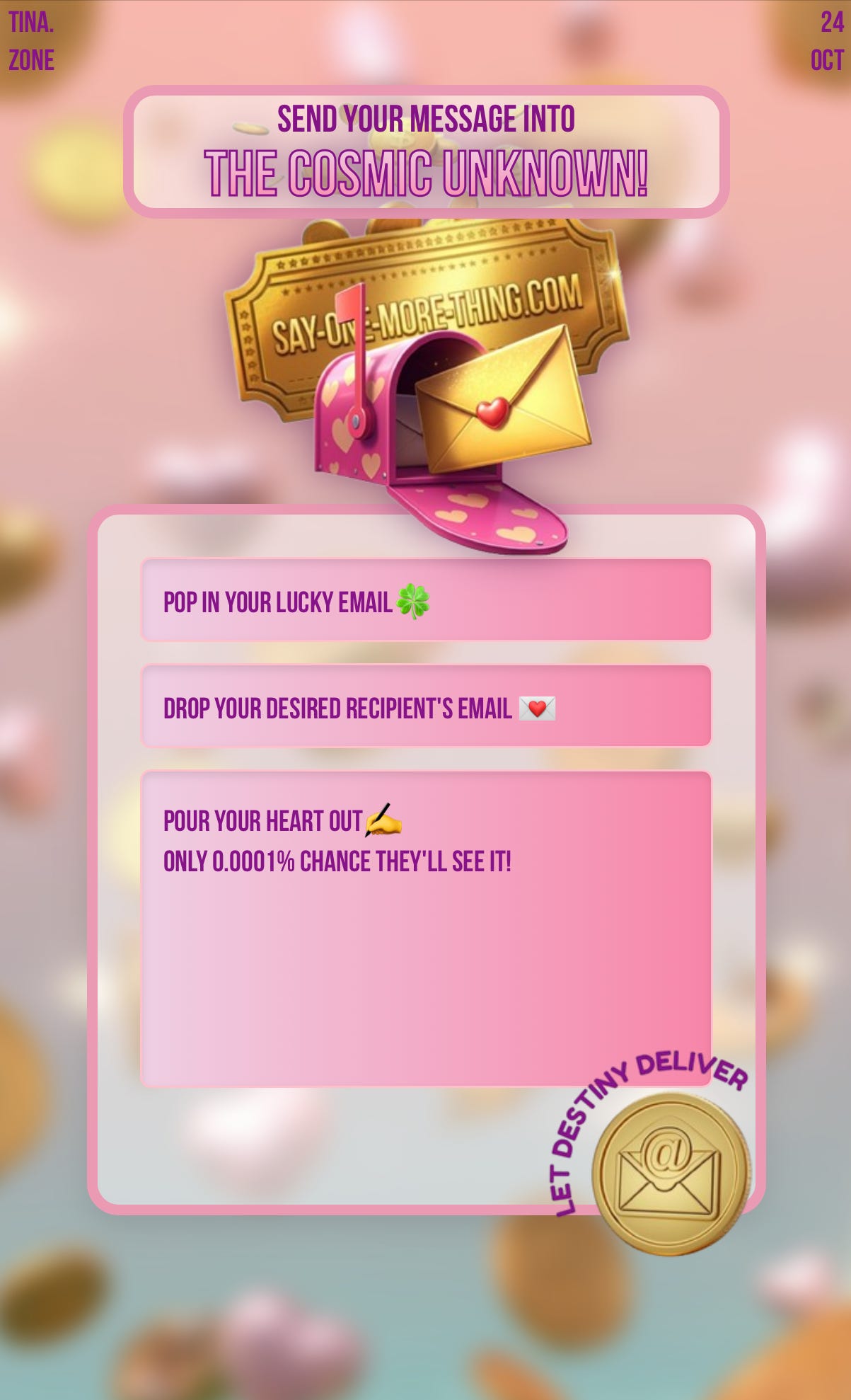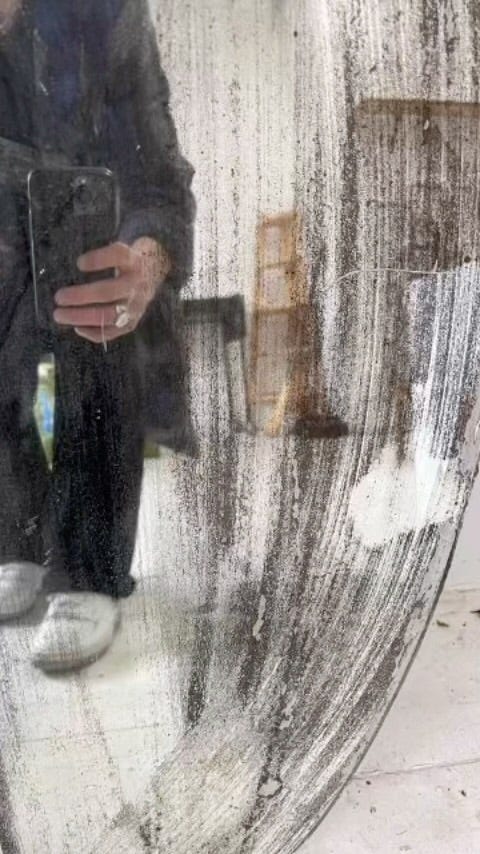This website uses your Instagram Explore page to help you 'find ur scrollmate'
Rithm, created by Tina Tarighian, asks, "What if we repurposed [the algorithm] for love?"
In this issue of PHONE TIME: Forget dating apps, and try to find your “scrollmate” on Rithm. Plus, a look at other projects by Tina Tarighian, including: an AI model that assumes what your husband looks like based on a picture of your face, imagine what’s left out of those Facebook Marketplace mirror listings, and have you ever wanted to say one more thing to an ex?

“There are only two people who know you better than you know yourself. Your mother, and Mark Zuckerberg, who for the better half of the last 20 years has watched your every move,” Tina Tarighian said at DEMO2025, a multi-day festival from NEW INC, the New Museum’s incubator.
She explained how Instagram’s algorithm, in particular, tracks your interactions with content, including how long you linger on specific posts, what you like, what you comment on, who you follow, and details including your age, gender, and location.
So why not use the fruits of that algorithm—presented back to you via your Explore page—to help you find love, or a “scrollmate”? That’s what Rithm, created by Tarighian, aims to do. “Other dating apps make you perform. Curate. Lie about loving hiking. Your algorithm already knows who you'd swipe right on,” Rithm’s about page describes.
The three main selling points for Rithm, as Tarighian presented at DEMO: no profile curation, no dumb prompts (“it doesn’t ask you about the soundtrack to your life”), and no algorithm.
Instead, you simply upload a screenshot of your Instagram Explore page, which Rithm calls a “scrollshot,” along with a few basic details like your name, gender preferences in dating, and age. You can then swipe left or right on others’ scrollshots. Your Instagram handle will only be shown to those you match with. Rithm will also give you a “digital pheromone,” or a description of the essences of your scrollshot.

The idea for Rithm came from an article Tarighian had read on Substack about how Hinge has become “a world of judging people on how well they curate themselves,” she said. It was also inspired by artist Tega Brain’s Smell Dating service, “where you would wear a white T-shirt for [a few days] without showering, send it back to her, and then other people could smell your musk and decide if they wanted to match with you.”
Rithm’s “digital pheromone” concept connects back to its scent equivalent, “where you don’t get to decide what represents you or what you smell like to other people.” And just as your exercise and diet will influence what you smell like IRL, your media diet will influence your digital pheromone.
In addition to being in NEW INC’s Year 11 cohort in the Extended Realities track and working as a Google Creative Lab creative technologist, Tarighian has made projects utilizing the web, augmented reality, and installations.
In college, she became interested in augmented and virtual reality. Having previously been a fine painter, she noted frustration in having to photograph work in order to get it out to other people. In contrast, “what’s so sexy about software” is that “it’s so ubiquitous that everyone can access it.”
Still, Tarighian described, many have resistance to being in a headset or looking at something through a phone, and even apps have accessibility limitations, due to the Android-iOS divide, for example.
Web art was appealing in that it is “about serving the same file to every single person,” she said. “It’s a miracle we have the free web. I think making art on it is more of a reason for it to continue to be protected.”
whatdoesmyhusbandlooklike.com

What does an AI model assume about you from just a picture of your face? This is the premise of whatdoesmyhusbandlooklike.com, which will return a picture of your husband—or whatever else you type in—based on a picture of your face (Tarighian assures users that none of the pictures they upload are saved by her or the model.)
Facebook Marketplace Mirrors
The theme of surveillance has “creeped its way into a lot of my work, in some way or another,” Tarighian told me.
In another project—which Tarighian made after trying to sell a mirror on Facebook Marketplace without getting herself in the photo—she looked through hundreds of listings of mirrors people were selling and ran the images through an image expander that filled out the photos with fake, assumed diffused pixels.
say-one-more-thing.com
“If it’s meant to be, it will be.” That’s the idea behind say-one-more-thing.com, an email lottery with a 0.0001%, or one-in-a-million chance, that what you type in will be delivered to the recipient within the next year.

Tarighian named managing the email lottery as an example of how her own projects have sometimes put her in the role of the surveillant.
“It’s a very weird, vulnerable relationship, especially with the email lottery stuff, because people will be like, ‘Only God will know if this sends.’ And I’m sitting there like, ‘Girl, I know,’” she said.
Given the breadth of Tarighian’s work and how it explores questions related to surveillance, algorithmic mediation, and artificial intelligence, I wanted to get her assessment about the future of the tech landscape. She noted generative AI’s use cases in making coding more efficient and being able to customize software, but emphasized that that shouldn’t overshadow its role in job displacement.
Tarighian also stressed the continued importance of human thought and taste. “There’s nothing I’ve come to appreciate more in my life than good, thoughtful design,” she said. “I adore a beautiful poster, a beautiful UI. It’s just not something I see going away.”
You can find Tina Tarighian’s work at tina.zone.



